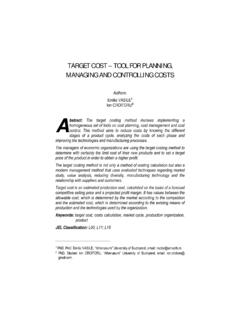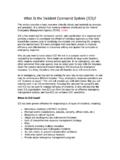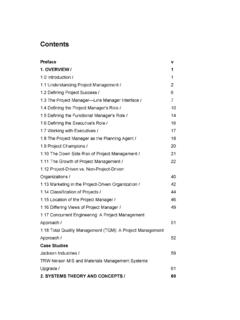Transcription of Business Intelligence Project Management 101: Managing BI ...
1 PMI Virtual Library 2010 Carole WittemannBusiness Intelligence Project Management 101: Managing BI Projects Within the PMI Process GroupBefore getting started, we need to make sure we understand Business Intelligence (BI) at a high the most of an organization s data assets is the purpose of BI. Companies can gain a competitive advantage for example, increasing revenue, reducing costs, or reducing risks by making better data-driven decisions through a well-built BI diverse Business applications of a BI system can be critically important to an organization. For example:Customer Profitability : Twenty percent of your customers make up 80 percent of your profit. Which customers are they? Which customers cost more money than they are worth?
2 A major Telco company let go of many customers after they conducted such analysis by building a profitability data sales : A major automotive company had difficulty reporting on part sales because there were By Carole Wittemann, PMPmultiple channels with different data sources. Once they built a BI system, they were able to see which parts were selling and where. With that knowledge they created (and tracked) marketing programs and competitive pricing programs to increase patient care : A regional healthcare provider with 20 hospitals needed a way to compare and report on clinical performance across all hospitals down to a patient-level. They built a BI system to allow that capability through a web-enabled dashboard while maintaining patient privacy and HIPAA reasons for building a BI system are 1) to identify and collect the data that resides in various internal and potentially external sources, and 2) to make that data available for reporting and BI PrimerAbstractToo many times, Business Intelligence (BI) and data warehousing Project managers are ill-equipped to handle their role in guiding a Project to success.
3 Often, the person slated to lead a Project is either 1) a technician who does not know the first thing about Managing a Project or 2) a Project manager who does not know the first thing about paper introduces Business Intelligence to the pure Project manager and introduces Project Management concepts to the BI practitioner in the context of an example Virtual Library | | 2010 Carole Wittemann2 Almost every application in an enterprise collects and stores data, and usually the data will reside in a relational database, but could also be stored in other formats. A diagram of a typical BI system is shown in Figure 1. Figure 1: Typical BI two main advantages of typical BI architecture are:Reporting from multiple systems is The data are stored and structured in a way that makes 2.
4 Reporting easy and diagram shows data flowing from left to right. On the left are multiple source systems, which often include Enterprise Resource Planning (ERP) and Customer Relationship Management (CRM) directly on source system data is called operational reporting, and is often included in a BI BI projects will have an Extract, Transform, Load (ETL) component. ETL refers to the technologies that move data between systems. All projects with an ETL component will need to consider how to handle data of dubious quality. Often separate data cleansing software is data supporting a BI application reside in the data warehouse (DWH). Although most modern BI tools can report from many sources and many types of data, the most common source is still the data warehouse.
5 Some projects will report from data marts, which are smaller subsets of a DWH, or an enterprise data warehouse (EDW) which is a data warehouse that attempts to include all important data for a company or enterprise. The structure of the tables in the DWH is the data model and is the most important component of any BI diagram shows a BI layer between the DWH and the reports. Different tools use different terms to refer to this layer: Project , universe, catalog, cube, framework, or semantic layer. Depending on the tools used, this layer is either an abstraction of data stored within the DWH, or a copy on disk or memory (often in a proprietary format) that allows easy, fast, and consistent reports themselves are usually fairly straightforward to build once the data have correctly been loaded into the DWH and the BI Layer has been properly built.
6 The trivializing of report-building is one significant benefit of BI. The goal of many BI projects is to enable Business people to build their own reports and do their own analysis rather than leaving the report-writing to Project Management Institute Process Groups Process Groups as defined by the Project Management Institute are stages used to manage a Project (or phase of a Project ) and are independent of the specific delivery methodology (waterfall, agile, etc.). A single Project may cycle through Process Groups multiple times depending on how the Project is structured and what kind of challenges the Project five process groups are:Initiation This is the first Process Group and acknowledges that the Project , or the next phase in an active Project , should Formulating and revising Project goals and objectives and creating the Project Management plan that will be used to achieve the goals the Project was undertaken to Putting the plan into action.
7 Including coordinating and directing Project resources to meet the objectives of the Project and Controlling - Taking performance measurements and analyzing them to determine if the Project is staying true to the Project Gathering and disseminating information to formalize the end of the Project You have just been assigned as the Project manager for an important Business Intelligence Project at a large bank. The goal of this Project is to enable quicker and more accessible information regarding the financial products sold and to better identify cross-sell and up-sell opportunities for the bank s customer initial Project phase will clearly define requirements and develop a detailed design.
8 Implementation of the system will occur in a later bank has identified two key sources of information needed to do the required analysis. They would like to enable ad hoc reporting to its analysts and have further identified 15 required (and complex) standard this Project , it has already been decided that a data mart approach will be used and the technology (software PMI Virtual Library | | 2010 Carole Wittemann3and hardware) has already been determined based on the company s corporate standards. We have determined that the successful completion of the following deliverables will define Project success:Requirements document focusing on data elements needed for standard reportsLogical and physical data model for data mart (in an ER modeling tool s format)Data-mapping document for ETL from two data sources into the data martDesign document including system diagrams Project plan and scope statement for next phase It is important to note that a Project or phase may go through each of the five Process Groups once or multiple times.
9 This hypothetical Project phase will assume that we will go through each of the five Process Groups Get the Project Started!Now that you understand what a BI Project entails and you are familiar with the PMI Process Groups, it is time to get started. The first task is to put together a draft of the Project charter with the executive sponsor to clearly define what Business needs the Project addresses. Review the Business purpose of the Project not only at the beginning of the Project , but also at the start of each our example, the executive sponsor is the CFO, as is typical in many implementations. Other senior executives such as the CIO or a high-level VP could also be the executive sponsor.
10 BI projects often fail if they lack sufficient executive Project charter (see Appendix for a sample Project charter template) will formally authorize a new Project or continue an existing Project into the next phase. A Project charter typically includes the high-level objectives, key stakeholders, and high-level description of deliverables, benefits, and critical success factors. This document will be the foundation for high-level objectives for our hypothetical Project include:Exposing comprehensive customer information to internal analysts and bankers at 100 branches of the bankDetermining and exposing any available information that could be used to identify cross-sell and up-sell opportunitiesBuilding an extensible BI system not only to be the foundation of the current requirements, but also to be capable of supporting future needs for 5-10 yearsStakeholders will exist at every level in the organization.








